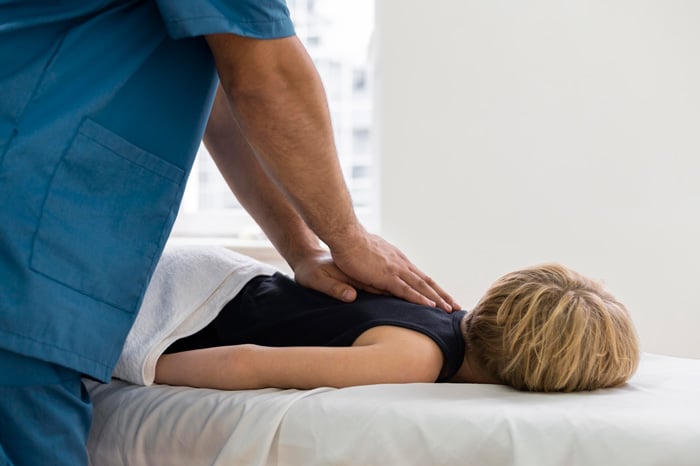Back cracking — why does it feel so good?
If you or a loved one says "I've had a bad back ever since I slipped a disc," then today's post is for you!

By Dr. Alexander Elahi
Is it OK to get your back cracked?
As a chiropractic physician, I was taught how specific we can get with our treatments to best help serve the needs of our patients. But without fail, every month at our Frederick clinic, new patients ask me why it feels SO good to get your back “cracked”? There are social media accounts specifically showing real-life spinal adjustments creating an audible “crack” followed shortly thereafter with a relaxing “ahh” exclamation by the patient.
What creates the audible noise that starts within the spinal joints?
Spinal joints are one example of a specific type of joint known as a synovial joint. Synovial joints in the body are composed of two opposing surfaces in a lubricating liquid called synovial fluid. In a physiological process known as “tribonucleation”, which is when two opposing surfaces resist separation, this resistance of separation eventually reaches a critical point whereby a force causes the opposing surfaces to quickly and briefly separate. When this separation takes place, the synovial fluid immediately has an increase in space as well as the new addition of a tiny gas bubble. It is the creation of this small gas pocket within the synovial joint that is responsible for the audible popping sound. So when manipulating the spine, or any synovial joint in the body, it is the process of tribonucleation that explains the audible noise associated with the manipulation.
Back in 2015, researchers were tasked with capturing this physiological phenomenon, which they successfully did with the help of an MRI scan. Check out this 6-second video of a finger synovial joint undergoing tribonucleation below.
So there is the physiological explanation as to the mechanism behind the audible noise, but what happens that makes getting your back “cracked” feel so good?
Why does spinal manipulation feel so good?
A few weeks ago, when setting up a patient on his side to manipulate his low back, my shoulder “popped” while pulling him into the final position BEFORE I had applied spinal manipulation to the patient. What happened next was interesting…
The patient let out an audible, “Ahhh” with a lengthy and very relaxing exhale.
But it was my shoulder that cavitated (or “popped”).
Why would he experience a feeling of relief when it wasn’t his joint that “popped”?
Approximately three out of four traditional chiropractic manipulations result in an audible pop. And many patients develop a natural Pavlovian response to relate their improvements to the most distinct aspect of treatment — the pop. Most patients look forward to the sound!
Quiet chiropractic manipulation?
Many patients believe that “if it cracks, you know it moved” and are often disappointed with silent manipulation. However, every major research study that examined this issue concluded that manipulation is equally beneficial regardless of whether a joint pops or not.
Some chiropractic techniques are designed to restore joint motion without a popping sound. Examples include Flexion-distraction, Drop table, Adjusting instrument, Directional preference, Mobilization, etc.
Should We Self-Adjust?
If this audible release creates a wonderful pain-modifying effect, then should we all just be popping our neck and back all day? Probably not — and here’s why:
An irritated or restricted joint may produce an ongoing urge to “pop it” yourself. Although self-adjusting may produce temporary relief, you should avoid the temptation for several reasons. Self-application of a crude generalized force to an entire region of the spine rarely frees the restricted culprit, but rather further loosens an already mobile segment. Over time, repeated self-mobilization could lead to NEW problems from creating excessive motion. Consequently, spinal manipulation should be performed only by chiropractors or other highly trained doctors who can recognize when an adjustment is appropriate and when it is not.
Is spinal manipulation all that is needed to treat back pain?
Probably not, and I am not an advocate for reliance on one treatment as an end-all-be-all guide to eliminating pain. Expert doctors and therapists all agree: an ideal treatment approach is one that encompasses more active than passive methods. If your doctor or therapist is heavily reliant on passive methods such as massage, electric stimulation, heat/ice, kinesiotaping, and posture correction, that is a red flag.
At our Frederick clinic, I utilize spinal manipulation regularly – when it is clinically indicated and within the guidelines for expert care. Every patient comes into our office looking to identify WHY they have back or neck pain, and our methods include stretching, flexibility, mobility, strengthening, and overall body awareness through individualized treatment and exercise routines.
In my opinion, treatment plans that rely primarily or exclusively on passive methods such as spinal adjustments, massages, vibration beds, etc. are NOT addressing the underlying issue but rather are masking the symptoms and providing short-term symptom modification.
If you or someone you know has been suffering with back pain, which prevents them from doing the activities they love, please forward this article over to them. Why? Because I believe that everyone in pain should have a chance at learning how to get back to the most fulfilling parts of their lives. Key Spine Care will help you get there.
Do This Next!
- Share this article with a friend or family member who has been dealing with constant back, neck, shoulder, hip, or knee pain that we could help!
- Call our office TODAY at 240-226-1440 to book your Assessment today.
- Keep an eye out for our next article!
